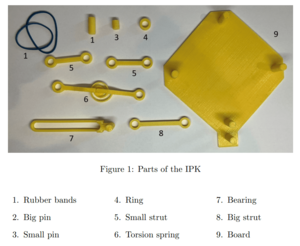
The instability phenomena can be observed in a practical way by using the 3D printed kit that contains all the necessary tools and connections to create different cases in an easy and fun manner. You can find the files for 3D printing here: www.thingiverse.com/thing:5421837
The instructions of use for the representation of each cases are explained in the following sections. The Elastic Stability Phenomena Kit (ESPK) contains different parts shown as follows:
Stable Symmetric Bifurcation with the ESPK[edit | edit source]
The symmetric stable case can be represented with items: 9 (Board); 6 (Torsion Spring); 7 (Bearing).
The torsion spring (6) is placed in one side at the board (9) position 1 and in the other side at the bearing (7) that is already in placed at the board (9) position 3. By pushing element 7 it is possible to observe a symmetric stable case.
Asymmetric Bifurcation with the ESPK[edit | edit source]
The Asymmetric stable case can be represented with items: 9 (Board); 8 (Big Strut); 1 (One Rubber Band); 2 (Big Pin).
By pushing on the item (2) in the direction of the strut, the asymmetric case can be observed. For the stable path, the strut should be deflected so the rubber band is stretched a little bit. For the unstable path, the strut should be deflected a little bit to the other direction.
Limit Point Bifurcation with the ESPK[edit | edit source]
The Limit Point case can be represented with items: 9 (Board); 1 (Rubber bands); 5 (Two Small Struts); 3 (Small Pin); 7 (Bearing).
The small struts (5) which are connected with the small pin (3) and placed on the board (9) on one side and in the bearing (7) on the other side. The rubber bands (1) are placed from the middle pin to each extreme pin.
The force should be applied in the union of the small struts (5) by pushing until the structure snaps through to the other side.